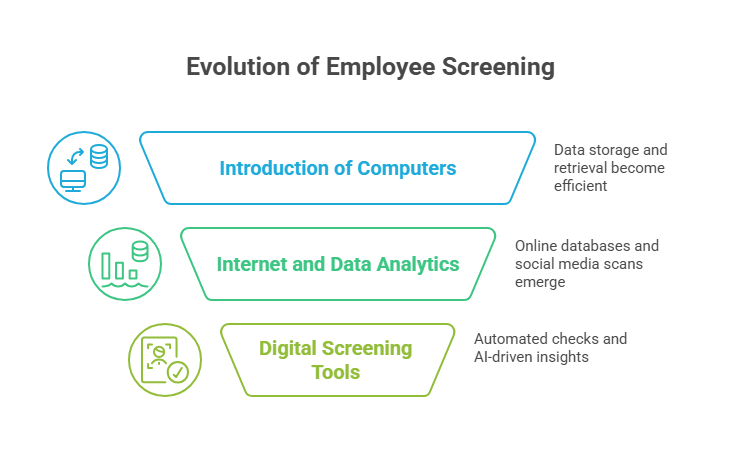In today’s fast-paced, tech-savvy world, traditional methods of employee screening are rapidly becoming outdated. The digital age has ushered in a myriad of new tools and techniques that revolutionize how businesses vet candidates. From online background checks to social media screenings, modern verification processes are designed to maximize efficiency and accuracy. This guide delves into the critical aspects of digital age screening, offering insights for business owners, HR professionals, recruiters, and job seekers alike.
Key Takeaways
- Digital age screening methods, including online background checks and automated reference checks, offer more accurate, efficient, and secure hiring practices compared to traditional methods.
- Social media screening, while valuable for assessing cultural fit and communication skills, requires careful consideration of ethical and privacy concerns.
- Tools like AI and machine learning can significantly enhance the hiring process but must be regularly audited to eliminate potential biases.
- Blockchain technology promises to revolutionize credential verification by providing decentralized and tamper-proof records, reducing the risk of fraud.
- Staying informed about emerging screening technologies and adhering to best practices in legal compliance and ethical considerations is crucial for both employers and job seekers.
EXPERT INSIGHT: We HR professionals exist at the point where human instincts and machine learning intersect—and that's where the future of recruitment really starts. AI provides us with velocity, accuracy, and information-driven insights, but it's our own human judgment that provides meaning to those insights. When we combine technology with empathy, we get more intelligent hiring processes, and more equitable and more human hiring processes. We're not trying to replace humans with machines, we're trying to empower humans with machines, creating workplaces where technology and trust go hand in hand. - Charm Paz, CHRP
Introduction
It's a new era in hiring. The days of relying solely on paper resumes and traditional interviews to screen candidates are fading fast. As technology advances, so too must our methods of vetting future employees. In adapting to digital age screening methodologies, businesses can stay ahead of the curve, ensuring they bring the right people on board efficiently and effectively.
In a nutshell, digital screening encompasses a range of modern verification techniques, including online background checks, social media screenings, automated reference checks, and digital identity verification. These practices leverage technology to enhance the accuracy and speed of the hiring process, reducing the chances of human error and outdated practices affecting crucial hiring decisions.
This guide aims to be a go-to resource for anyone involved in the hiring process—business owners, HR professionals, recruiters, and even job seekers. We’ll provide a comprehensive look at how digital age screening works, the tools available, and best practices to ensure you’re making informed and fair hiring decisions.

Understanding Digital Age Screening
Digital age screening refers to the use of advanced technological tools and methodologies to vet potential employees. Traditionally, employee screening involved manual background checks, reference calls, and sometimes, in-person verification. But with the advent of technology, these processes have become more efficient, comprehensive, and reliable.
Evolution
The progression from traditional to digital screening is a reflection of broader technological advancements that have permeated almost every industry. Initially, employee screening was primarily paper-based, involving physical records and in-person interviews. The introduction of computers revolutionized the storage and retrieval of data, making it easier to maintain extensive databases of employee information.
The big shift came with the internet and the burgeoning field of data analytics. Online databases and digital footprints created by social media profiles, professional networks, and other online activities became valuable resources for screening. Companies began leveraging online background checks and social media scans to gain more insightful, real-time data about candidates.
Importance
In today's competitive and fast-paced job market, digital screening is crucial for several reasons. First, it dramatically speeds up the hiring process. Automated checks for criminal history, employment verification, and education credentials can be completed in mere minutes compared to the days or even weeks required by traditional methods.
Second, digital screening improves accuracy and scope. Leveraging big data and AI, these technologies can uncover discrepancies or hidden information that might be missed in manual checks. This thoroughness is vital in minimizing the risk of hiring individuals who might not be a good fit, either culturally or skill-wise.
Lastly, digital screening enhances security and compliance. With regulations such as the Fair Credit Reporting Act (FCRA) and Equal Employment Opportunity Commission (EEOC) guidelines, companies need to adhere strictly to legal standards. Digital tools often come with built-in compliance checks, ensuring that all processes are within the bounds of the law.
In sum, understanding and adopting digital age screening methods equip businesses with the tools they need to make informed, timely, and legally sound hiring decisions.

Types of Digital Screening Techniques
Online Background Checks
Online background checks have swiftly become a cornerstone of digital-age screening. They involve a thorough examination of a candidate's history, typically including criminal records, employment history, educational background, and credit reports. This process leverages vast digital databases to provide a comprehensive profile of a potential employee.
Pros and Cons:
- Pros: Efficiency and speed are major advantages. Online background checks can be completed in a fraction of the time compared to traditional methods. They also offer a broad scope of information, which can be crucial for making informed hiring decisions.
- Cons: On the downside, the accuracy of these checks can sometimes be called into question. Misidentifications and outdated information are possible pitfalls. Additionally, there are privacy concerns that must be carefully managed.
Key Vendors: Reliable sources for online background checks include consumer reporting agencies accredited by the Professional Background Screening Association (PBSA).
Social Media Screening
Social media screening involves analyzing a candidate's social media profiles to gain insights into their character and personal life. With platforms like LinkedIn, Facebook, and Twitter being rich sources of personal information, they are invaluable tools for employers.
Ethical Considerations:
- Pros: Social media screening can reveal aspects of a candidate's personality, professionalism, and cultural fit that traditional methods might miss.
- Cons: Ethical and legal implications are abundant. Privacy concerns are paramount, and there's the risk of unconscious bias influencing hiring decisions.
Benefits and Risks:
- Benefits: Employers can gauge a candidate’s communication skills, professionalism, and overall presence.
- Risks: However, there's a fine line between professional vetting and personal invasion. Misinterpreted information can lead to unfair evaluations.
Automated Reference Checks
Automated reference checks streamline the process of collecting and verifying references. These tools send out standardized questionnaires to referees, gather responses, and provide a summarized report to the hiring manager.
Accuracy and Reliability:
- Accuracy: Automated systems reduce human error and bias, leading to more consistent and reliable data.
- Reliability: They ensure speed and efficiency, making the process quicker and less cumbersome.
Impact on Hiring Decisions: Effective use of automated reference checks can provide valuable insights that significantly impact hiring decisions, ensuring that references are checked thoroughly and objectively.
Digital Identity Verification
Digital identity verification uses technology to confirm a candidate’s identity through various means, such as biometric scans or digital document verification.
What Is It?: This entails using advanced technologies, including AI-driven algorithms, to ascertain the authenticity of a candidate’s documents and credentials.
Implementation: Organizations can integrate these verification tools into their hiring workflows through APIs or specialized platforms, ensuring seamless and secure operations.

Best Practices for Employers
Benefits: The primary advantage is enhanced security and accuracy. Digital identity checks can weed out potential fraudsters and ensure that the candidate is who they claim to be, fostering a trustworthy hiring process.
Navigating the maze of digital employee screening tools can be daunting. With numerous options available, knowing the best practices helps you make informed decisions while ensuring legal compliance and ethical integrity.
Legal Compliance
Staying within the bounds of the law is paramount when implementing any screening process.
- Regulations: Familiarize yourself with key regulations such as the Fair Credit Reporting Act (FCRA) and the Equal Employment Opportunity Commission (EEOC) guidelines. These laws govern what you can and cannot do during background checks. Violating them not only risks legal repercussions but can also damage your company's reputation. Refer to resources like the EEOC’s Guidance and DOL Hiring Topic to stay updated.
- Documentation: Maintain accurate records of all screenings. This not only aids in compliance but provides a clear audit trail should any disputes arise.
- Training: Ensure your HR team is well-versed in legal requirements. Regular training sessions can help keep everyone updated on any changes in the laws.
Ethical Considerations
Adherence to ethical standards is crucial to fostering a positive hiring experience.
- Transparency: Always be upfront with candidates about the types of screenings you conduct. Provide them with a clear understanding of what to expect and why it’s necessary. Transparency builds trust and can even enhance your company’s image.
- Consent: Obtain explicit consent from candidates before conducting any background checks, social media screenings, or reference verifications. Doing so not only complies with legal requirements but also respects candidates' privacy.
- Fairness: Ensure that your screening process is objective and free from biases. Use consistent criteria for evaluating all candidates to avoid discrimination. This fosters a fair and equitable hiring process.
Choosing the Right Tools
Selecting the correct screening tools is vital for efficiency and effectiveness.
- Vendor Assessment: Evaluate screening tool vendors based on their reliability, accuracy, and compliance with legal standards. Look for vendors with a solid track record and positive user reviews.
- Budgeting: Allocate your budget wisely. While cutting costs is tempting, investing in high-quality screening tools can save you money in the long run by reducing the risk of bad hires.
- Integration: Ensure that your screening tools seamlessly integrate with your existing hiring systems. Smooth integration can streamline your hiring process, making it more efficient and less prone to errors.
By following these best practices, employers can enhance the effectiveness of their screening processes while staying within legal and ethical boundaries. This not only improves the quality of hires but also builds a trustworthy and transparent hiring environment.
Preparing Job Seekers for Digital Screening
Personal Data Management
First and foremost, managing your data is crucial in the digital age. Start by cleaning up your social media profiles—employers often check these during the hiring process. Remove any content that could be deemed unprofessional or controversial, and focus on showcasing your skills and experiences relevant to your industry.
Consistency across all platforms is also vital. Make sure that the information on your resume aligns with your LinkedIn profile and other professional social media accounts. Discrepancies can raise red flags and undermine your credibility.
Lastly, adjust your privacy settings to control what potential employers can see. Protect your personal information while still presenting a professional front. This balance is key to maintaining both privacy and transparency.
Communication
Honesty is the best policy when it comes to navigating digital screening. Be upfront about your employment history, qualifications, and any gaps or discrepancies that might come up. Transparency will never go out of style, and it helps build trust with potential employers.
Know the common red flags that employers look for in background checks. For instance, undisclosed criminal records or significant inconsistencies in job history can be deal-breakers. Understanding these can help you address potential issues proactively.
Digital Literacy
Stay updated on how technology affects the job market. Knowing the latest digital screening trends and tools can give you a competitive edge. Whether it's understanding how algorithms sort through resumes or the basics of AI in hiring, staying informed helps you navigate the landscape with confidence.
Additionally, invest in improving your digital skills. This could mean taking online courses relevant to your field or merely becoming more adept at using professional networking sites. The more digitally literate you are, the better prepared you'll be to meet modern job market demands.
Future Trends in Digital Screening
AI and Machine Learning
Artificial Intelligence (AI) and Machine Learning (ML) are poised to redefine employee screening. These technologies can analyze vast amounts of data quickly, revealing patterns and insights that traditional methods might miss. For instance, AI can help create more nuanced profiles of candidates by assessing their digital footprint, from social media activity to professional networks. This leads to more informed hiring decisions. However, the key challenge lies in ensuring these technologies do not perpetuate existing biases—hence, it's crucial to regularly audit AI systems for fairness and accuracy.
Blockchain
Blockchain technology offers a novel solution to enhancing security and transparency in employee screening. By creating decentralized and tamper-proof records, blockchain makes it possible to verify credentials (like academic degrees or work history) rapidly and securely. Instead of relying on potentially falsifiable documents, employers can access verifiable records directly from the source. This reduces the risk of fraud and accelerates the verification process. While still in its early stages, the adoption of blockchain in HR screening looks promising.
Predictive Analytics
Predictive analytics leverages data to forecast future outcomes. In the context of hiring, this means using candidate data to predict their potential performance and cultural fit. By analyzing past hiring data and correlating it with employee performance metrics, predictive analytics can help identify traits and backgrounds that correlate with success in specific roles. This proactive approach allows recruiters to focus on candidates who not only meet the job requirements but also have the potential to excel. It's a powerful tool for improving the long-term quality of hires.
These emerging trends underscore the importance of staying abreast of technological advancements in digital screening. They promise a future where hiring is not only more efficient but also more precise and secure. As these technologies evolve, continuous learning and adaptation will be crucial for both employers and job seekers navigating the digital age.
Conclusion
In summary, digital age screening is an essential, transformative process that has evolved significantly from traditional methods. By leveraging online background checks, social media screenings, automated reference checks, and digital identity verification, employers can ensure more accurate, efficient, and secure hiring practices. These technologies offer unparalleled advantages in the current job market, enabling businesses to make informed decisions swiftly and fairly.
We encourage both employers and job seekers to embrace these digital screening tools as vital components of future-proof hiring strategies. Digital screening not only enhances the reliability of recruitment but also aligns with the modern demands of transparency, ethical considerations, and legal compliance.
As the landscape of employee vetting continues to evolve, staying informed and adaptable is paramount. Continue educating yourself about the latest trends and best practices in digital screening by exploring reputable resources like The PBSA. Adapting to these advancements is not just about keeping up—it's about leading the way to a more efficient and trustworthy hiring future.
Still have questions?
Get in touch with our team today for a personalized demo and discover how our tailored volume pricing and packages can drive results for your business!
How useful was this page?*
Note: your comments are anonymous. We use them to improve the website. Do not include any personal details.
Visit our FCRA Compliance Tool or leave a message here if you need a response.
From the blog Explore the GCheck Content Hub

How Long Does a Background Check Take? A Complete 2025 Guide
13 Dec, 2023 • 14 min read
The Ultimate Background Check Guide
13 Dec, 2023 • 4 min read
The Ultimate Guide to Employment Background Checks
13 Dec, 2023 • 10 min readThe information provided in this article is for general informational and educational purposes only and should not be construed as legal advice or a substitute for consultation with qualified legal counsel. While we strive to ensure accuracy, employment screening laws and regulations—including but not limited to the Fair Credit Reporting Act (FCRA), Equal Employment Opportunity Commission (EEOC) guidelines, state and local ban-the-box laws, industry-specific requirements, and other applicable federal, state, and local statutes—are subject to frequent changes, varying interpretations, and jurisdiction-specific applications that may affect their implementation in your organization. Employers and screening decision-makers are solely responsible for ensuring their background check policies, procedures, and practices comply with all applicable laws and regulations relevant to their specific industry, location, and circumstances. We strongly recommend consulting with qualified employment law attorneys and compliance professionals before making hiring, tenant screening, or other decisions based on background check information.


